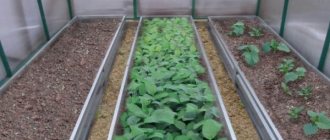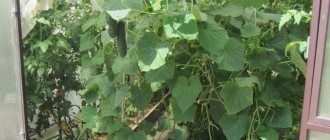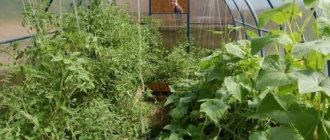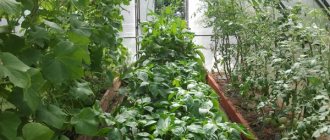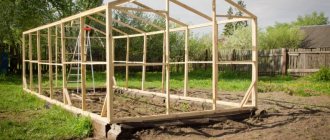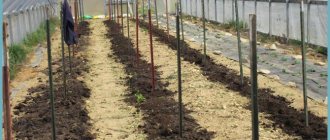For those who do not know what can be planted in a greenhouse along with cucumbers, you need to familiarize yourself with the requirements for growing these plants. In the neighborhood you should not plant crops with cucumbers that will take away nutrition and strength from them, or block the light. It is desirable that neighboring crops require the same care, nutrition, and watering. This will reduce time and avoid getting confused in many cultures.
Usually different vegetables are planted together in a greenhouse due to the small space in the garden. This way you can achieve variety in your garden. Knowing what can be grown in a greenhouse along with cucumbers, summer residents plant shrubs. If you do not make mistakes in these plantings, you can get quite a decent harvest.
Why some crops cannot be planted next to cucumbers
The space on the site for installing a greenhouse is limited, so you need to select neighbors very carefully. For many decades, people have been studying the interaction between neighboring plants. Proper placement of crops helps protect them from diseases and pests, as well as increase productivity. And all this without the constant application of mineral fertilizers, which saves money and makes the products more environmentally friendly.
Plants create favorable conditions for each other for growth, healing the soil, feeding it with useful substances, in particular nitrogen. Other plants loosen the soil with their roots, prevent harmful weeds from growing, and prevent soil depletion and weathering.
Some plants attract pollinating insects for various crops in the garden, as well as birds and pest-killing insects. Other plants drive away rodents and harmful insects that spoil the crop.
It is also necessary to think through a planting plan because different crops require special growing conditions. What is good for one may be bad for another. Cucumbers require moist air and constant maintenance of moist soil, infrequent but plentiful. These conditions are not suitable for many garden plants. For example, it is difficult for nightshades (potatoes) to grow next to cucumbers; they become depressed and weak. High temperature and humidity are not good for tomatoes. However, some gardeners successfully grow tomatoes with cucumbers. An example will be the heroine of the video posted at the end of the article.
Features of growing cucumbers
Cucumbers need to be planted on fertile, light and warm soil that does not become waterlogged and contains many nutrients. In the fall, when preparing the bed for the next year, rotted manure or compost is added at the rate of 5-6 kg per 1 sq.m. When decomposition processes begin, heat is released and the bed is saturated with nutrients. And cucumber leaves absorb carbon dioxide released during the decomposition of manure.
Every morning, the cucumbers are watered with warm, settled water. They have a superficial root system, which is also fragile and delicate. Lack of oxygen and damage lead to their death, or damage to spider mites and diseases. Therefore, the soil must be kept loose and moderately moist. This option is not suitable for most plants.
Cucumbers are picky about temperature.
When it drops to 10 degrees, the leaves turn yellow and growth stops. When it drops to 5 degrees and below, the leaves fall off and are affected by powdery mildew. And when the air temperature rises, the pollen in the flowers sticks together, they are not pollinated, and the flowers fall off.
It is best to grow cucumbers vertically; to do this, they are tied to a trellis. This makes them easier to care for and reduces the risk of disease and pest damage.
This growing principle is not suitable for all plants. Not all crops are suitable for growing together with cucumbers for the following reasons:
- Spreading mustaches of cucumbers can oppress neighbors in the garden.
- Also, on the contrary, neighboring plants may have too strong a root system, which will not allow the cucumber plant to develop.
- Other plants will draw all the moisture from the ground, which creates extremely unfavorable conditions for cucumbers.
- It is not recommended to grow plants belonging to the same family nearby, as they will “argue” with each other.
- Neighbors can consume a lot of nitrogen, which is necessary for the growth and development of cucumbers.
What conditions does the cucumber plant like?
Cucumbers are greenhouse plants. Summer residents mainly grow cucumbers in a polycarbonate greenhouse. The question of what other crops can be planted in the greenhouse next to them depends on what conditions the cucumber plants prefer.
Cucumbers love heat very much. They also prefer good lighting. Variability of weather conditions and temperature fluctuations mainly frighten them. The greenhouse should be fairly humid; they prefer a humid climate. Frequent watering for cucumbers in a greenhouse is required. Cucumbers also grow well only on fertile soil, which must be periodically loosened and fertilized. Humus and manure have a good effect on them, but an excess of nitrogen impairs fruiting.
Therefore, you can plant next to them only those plants that have similar needs, so that they are easier to care for . This is the only way to achieve a good harvest. It is worth noting that not all crops get along well with cucumbers. Some only prevent them from growing.
What can you plant in a greenhouse next to cucumbers?
Before you organize your garden, look at which crops get along well next to cucumbers, which will be good predecessors and successors after green vegetables.
Cucumbers get along well with the following crops.
Eggplant
Crops have similar requirements for watering and care. When growing them together, you need to provide the cucumbers with supports for the vines in time, then they will not oppress each other. If you plant eggplants in a greenhouse together with cucumbers, then plant the eggplants in a sunny place first, since the wide leaves of cucumbers can shade them.
Will bell peppers grow along with cucumbers?
This is another advantageous neighborhood. Peppers like the same growing conditions as cucumbers. They do not tolerate drafts, dry soils and dry, hot air. Just tie up the vines so as not to shade the nightshade crop. Cabbage and peppers are also excellent predecessors for garden beds in front of cucumbers.
Here's what you can plant in a greenhouse with cucumbers
Zucchini
Both cultures do not oppress each other. Their proximity is not dangerous, since they do not inter-pollinate, although they are relatives. Both plants love water and light. But make sure that the large zucchini leaves do not shade the cucumber leaves.
Corn and cucumbers
For large garden plots this is one of the best combinations. Corn serves as a curtain for cucumbers, protecting them from the scorching sun and drafts. The root systems differ: in the first they go deep, in the greenfinch they are superficial. Plus, the vines of cucumbers curl perfectly along the stems of a strong neighbor.
Neighborhood of cucumber and onion
Both plants are friendly to each other. The meadow is also an excellent predecessor for cucumbers. But it is better not to plant onions immediately after cucumbers; first grow legumes in this place.
Is it possible to plant garlic next to cucumbers?
This neighbor is great for cucumbers. It repels pests.
Peas and beans near cucumbers
Legumes saturate the soil with nutrients, especially nitrogen. Therefore, if they grow nearby or even in the middle of the garden bed, the yield of cucumbers increases.
Chives
If you plant both crops side by side, cucumbers will not suffer from powdery mildew.
Will cucumbers grow next to carrots?
These plants in neighboring beds do not negatively affect each other in any way.
Is it possible to plant dill with cucumbers?
This aromatic herb is an exception among spicy plants; it is not advisable to plant others. It is useful to grow wormwood, thyme and thyme nearby; they repel pests such as slugs that eat young fruits.
Cucumbers also work well with radishes, different varieties of cabbage and broccoli, mustard and spinach.
Useful articles:
Growing radishes
How to grow cabbage
Growing and caring for Broccoli
When to sow and when to bury mustard in the ground
Many gardeners are concerned about whether it is possible to plant different varieties of cucumbers side by side . There is no definite answer, since if the varieties are pollinated, then as a result of proximity they can be cross-pollinated. If the varieties are self-pollinating, then nothing bad should happen. But even in the first case this is not catastrophic. It all depends on whether you will use grown seeds or plant purchased ones every year. In case of cross-pollination, fruits can receive varietal characteristics of each other. For home use this is not important .
Another opinion about the proximity of zucchini and cucumbers in the same greenhouse
According to standard recommendations, these plants can be planted together, since they develop in the same conditions. Most believe that the main problem of the proximity of crops is that large zucchini leaves can shade cucumber vines. If this problem is solved by proper planning of the beds and applying a sufficient amount of fertilizer for both crops, then nothing will interfere with the growth of both species.
But in practice, many face a number of problems. The first is diseases. When grown together, both plants are often affected by powdery mildew and spread very quickly. The second nuance characteristic of bee-pollinated varieties is that the pollination process is disrupted. The harvest that grows is frail, and sometimes there is none at all. In addition, zucchini has a highly developed root system, and it can inhibit cucumbers.
What not to plant next to cucumbers
And although it is believed that cucumbers do not have an unfortunate neighborhood, there are nevertheless a number of plants that should not be planted next to cucumbers. These include:
- basil, arugula and other aromatic, fragrant herbs. They oppress cucumbers.
- fennel _ It has a powerful root system that grows strongly and draws all the moisture and nutrients from the soil.
- tomatoes . Nightshades take the same nutrients from the soil that cucumbers need. Plus they require completely different growing conditions. Next to cucumbers, they will simply drown and will constantly get sick. However, there is no clear opinion among gardeners on this matter. If you maintain distance and agricultural technology, then tomatoes and cucumbers can coexist in the same greenhouse.
- potato. The situation with it is the same as with tomatoes. Plus, cucumbers and potatoes are mutually inhibiting plants. Potatoes take up all the water and nutrients and shade the cucumbers. In addition, they share common pests and diseases.
- strawberry . Plants require different care; from frequent watering, garden strawberries will quickly drown and begin to hurt. But cucumbers do not like very sunny places, their leaves turn yellow, and productivity decreases.
- Watermelons and melons belong to the same family as cucumbers. Therefore, in order to avoid cross-pollination, it is undesirable to plant them next to each other. Plants will oppress each other. The leaves of melon and watermelon are much larger than cucumber leaves, so they will shade them.
Basic rules of crop rotation
Proper rotation of crops is the key to high productivity. There are good and bad predecessors for cucumbers.
Nightshades and legumes are considered good predecessors. The only exception is beans. Speaking of nightshades, it is worth highlighting potatoes and tomatoes. Cucumbers also grow well after onions, of any variety. They can be successfully grown after cauliflower or white cabbage and many root vegetables. Carrots and beans cannot be included here, as they are susceptible to white rot (this disease is fatal to the cucumber crop).
Beetroot is a neutral precursor. Also, without any problems, the crop can be planted in the garden bed where radishes were previously collected.
Expert opinion
Stanislav Pavlovich
Gardener with 17 years of experience and our expert
Ask a Question
The pumpkin family is considered the worst predecessors. It is not recommended to grow cucumbers in the place where pumpkin, zucchini or squash previously grew; these crops are susceptible to identical diseases.
To prevent depletion of soil in the garden plot, it is necessary to organize crop rotation. Cultures must be alternated. Fertilizing the soil alone will not do it. Vegetables, fruits or herbs are rotated based on the nutrient dependency of each individual crop.
Cucumbers, like their predecessors, are demanding on soil and fertilizers. After them, you can plant potatoes, turnips, radishes, carrots, beets or celery, since these plants are not picky about the composition of the soil.
Important! Planting of cucumbers is carried out with preliminary fertilization of the soil with mineral compounds and organic fertilizers, regardless of who the crop will grow next to.
Zoning and partitions
Zoning a garden plot is an important part of its organization. If the beds are placed chaotically, then not all crops will receive the necessary care. Planting should be done in a certain order and with a convenient location of the water source. This will help maintain enthusiasm for caring for the area and prevent it from developing into a duty and punishment.
Significant points in organizing the site are the following:
- Zone the beds according to the rule: the more care required, the closer they need to be. The same applies to greenhouses. If you feel unwell or don’t want to, the plants will be at hand, and you won’t have to drag heavy buckets and a hose to water the beds.
The same system works for mixed beds. Plant things that need frequent watering closer together. If you combine cucumbers with anything else, then place the cucumbers closer.
- Look where the shadow falls. Partial shade is suitable for cucumbers; they will produce a little less yield, but they will not get sick. That's why they are planted next to sunflowers and corn.
- Separate cucumber beds with borders, flowers or greenery. Onions, garlic, marigolds, dill and thyme are suitable for this. This will help limit the decaying vines of cucumbers and preserve the fruits from damage while walking along the paths. Broken brick, tiles, slate, large pebbles, even empty bottles are suitable for creating a border.
- Place natural hedges on the east and south sides. This will help protect the cucumbers from the hot sun during the heat of the day.
Another condition for successfully growing cucumbers is the installation of a modern irrigation system. This will make it easier to irrigate on time when you are unable to do it yourself.
Friendly seven
Corn . Corn stalks will serve as a natural support for climbing cucumber plant vines, saving you the labor cost of trellis construction.
However, there is one caveat. In this case, you need to choose cucumber varieties with light and small fruits, otherwise the corn stalks will not bear the weight of the lashes with large cucumbers. In return for support, cucumbers will provide the corn with a natural mulch under the stalks, conserving moisture and inhibiting weed growth.
Sunflowers . Similar to corn plants, tall and strong sunflowers are also ready to support cucumber vines.
Thanks to the variety of varieties and hybrids, modern sunflowers look for every taste: from dwarfs 50 cm tall to giants reaching a height of three meters, with petals of all shades - from pale yellow to orange and red, in one or two layers.
It should be remembered that the shells of sunflower seeds contain a substance that is toxic to the grass. So, you will either need to harvest your sunflower before the seeds start to fall if you plan to plant anything in that spot next season.
Dill. This popular and beneficial aromatic plant attracts pollinating insects such as bees and parasitic wasps. The former will help cucumbers with pollination, and the latter will regulate the level of pests. There is also an opinion that dill improves the taste of cucumbers.
Nasturtiums . Beautiful flowers and natural traps for aphids will distract the pest's attention.
Marigolds . Perhaps the most sought after companions, repelling a wide range of pests. First, the roots and stems emit a chemical that is unpleasant to insects, and second, the petals contain the same chemical. Therefore, you can pick the petals and scatter them around the cucumber plants.
Root vegetables . Cucumber plants produce one large tap root, while the rest of the roots remain thin and shallow, spreading only 15-30 cm around. This means carrots, turnips, radishes and radishes can be planted nearby. Radish is recommended as a way to repel flea beetles - the worst enemies of cucumbers.
Bad neighbors
Fennel . This plant is generally hostile to other crops, as it is actually a strong inhibitor of the growth of most other plants, and cucumber is no exception.
Cabbage . Plants of the Brassica family (such as cabbage or cauliflower) have a complex relationship with cucumbers. Despite the fact that some gardeners believe that cabbage improves the growth of cucumbers, in fact, the crop greedily absorbs water from the soil, and when planted nearby, competes for soil moisture.
Melon . Both plants have long vines that become tangled when close together, and also attract the same pests.
Potato . The same diseases with the cucumber crop and severe competition for nutrients in the soil. It is better to plant them further away from each other.
Sage . Unlike dill, it spoils the quality of the fruit. Because cucumbers have a fairly subtle flavor (they are, after all, 95 percent water), overly potent "flavorings" like sage and mint can be detrimental to the flavor profile.
Source
Conclusion
We told you what you can plant in a greenhouse with cucumbers. The culture gets along well with many plants, so organizing beds for cucumbers is not difficult. If you don’t plant a number of crops nearby, you will get a bountiful and tasty harvest.
Erets are excellent predecessors for the beds in front of cucumbers.
Here's what you can plant in a greenhouse with cucumbers
Zucchini
Both cultures do not oppress each other. Their proximity is not dangerous, since they do not inter-pollinate, although they are relatives. Both plants love water and light. But make sure that the large zucchini leaves do not shade the cucumber leaves.
Corn and cucumbers
For large garden plots this is one of the best combinations. Corn serves as a curtain for cucumbers, protecting them from the scorching sun and drafts. The root systems differ: in the first they go deep, in the greenfinch they are superficial. Plus, the vines of cucumbers curl perfectly along the stems of a strong neighbor.
Neighborhood of cucumber and onion
Both plants are friendly to each other. The meadow is also an excellent predecessor for cucumbers. But it is better not to plant onions immediately after cucumbers; first grow legumes in this place.
Is it possible to plant garlic next to cucumbers?
This neighbor is great for cucumbers. It repels pests.
Peas and beans near cucumbers
Legumes saturate the soil with nutrients, especially nitrogen. Therefore, if they grow nearby or even in the middle of the garden bed, the yield of cucumbers increases.
Chives
If you plant both crops side by side, cucumbers will not suffer from powdery mildew.
Will cucumbers grow next to carrots?
These plants in neighboring beds do not negatively affect each other in any way.
Is it possible to plant dill with cucumbers?
This aromatic herb is an exception among spicy plants; it is not advisable to plant others. It is useful to grow wormwood, thyme and thyme nearby; they repel pests such as slugs that eat young fruits.
Cucumbers also work well with radishes, different varieties of cabbage and broccoli, mustard and spinach.
Useful articles:
Growing radishes
How to grow cabbage
Growing and caring for Broccoli
When to sow and when to bury mustard in the ground
Many gardeners are concerned about whether it is possible to plant different varieties of cucumbers side by side . There is no definite answer, since if the varieties are pollinated, then as a result of proximity they can be cross-pollinated. If the varieties are self-pollinating, then nothing bad should happen. But even in the first case this is not catastrophic. It all depends on whether you will use grown seeds or plant purchased ones every year. In case of cross-pollination, fruits can receive varietal characteristics of each other. For home use this is not important .
Good neighborhood
Cucumbers grow in almost every summer cottage. To obtain a useful harvest of good quality, gardeners should know which neighbors are considered the most successful for the crop and why.
Corn
This plant does not deprive cucumbers of the nutrients they need and protects them from gusty winds. Cucumber vines can be fixed to its stems; in such conditions they will feel comfortable, and the yield will increase by 20%.
Onion
Cucumbers have an excellent relationship with onions. Thanks to phytoncides, it will protect cucumbers from many diseases and pests.
Garlic
Garlic gets along well with cucumbers. But it is better to plant it between the beds. This way it will promote the growth of greenery and repel annoying pests.
Cabbage
The optimal solution for the neighborhood. In this crop, the root penetrates deep into the soil, which helps it draw moisture from the ground. For its growth, the minerals required for cucumbers are not used.
It can be placed either on an adjacent plot or interspersing crops. The main thing is to keep your distance so that the plants have enough space to fully develop.
Beet
Beets will normally coexist with cucumbers. But it is advisable to give preference to early varieties. While the cucumber fruits are ripening, the root vegetables can already be harvested. Otherwise, the cucumber shoots will begin to take away the sunlight required for the beets.
Peas and beans
The roots of these legumes are a source of nitrogen compounds, which cucumbers really need. It is recommended to leave the stems of these crops in the soil even after harvesting.
Radish
This crop is not demanding of heat, but it does need a lot of moisture. Because of this, radishes can be planted along a bed with cucumbers without any doubt. This close proximity will not prevent the growth of vines and will ensure the harvest of the crop itself.
What not to plant next to cucumbers
And although it is believed that cucumbers do not have an unfortunate neighborhood, there are nevertheless a number of plants that should not be planted next to cucumbers. These include:
- basil, arugula and other aromatic, fragrant herbs. They oppress cucumbers.
- fennel _ It has a powerful root system that grows strongly and draws all the moisture and nutrients from the soil.
- tomatoes . Nightshades take the same nutrients from the soil that cucumbers need. Plus they require completely different growing conditions. Next to cucumbers, they will simply drown and will constantly get sick. However, there is no clear opinion among gardeners on this matter. If you maintain distance and agricultural technology, then tomatoes and cucumbers can coexist in the same greenhouse.
- potato . The situation with it is the same as with tomatoes. Plus, cucumbers and potatoes are mutually inhibiting plants. Potatoes take up all the water and nutrients and shade the cucumbers. In addition, they share common pests and diseases.
- strawberry . Plants require different care; from frequent watering, garden strawberries will quickly drown and begin to hurt. But cucumbers do not like very sunny places, their leaves turn yellow, and productivity decreases.
- Watermelons and melons belong to the same family as cucumbers. Therefore, in order to avoid cross-pollination, it is undesirable to plant them next to each other. Plants will oppress each other. The leaves of melon and watermelon are much larger than cucumber leaves, so they will shade them.
Cucumber Company – 7 Friendly Plants and a List of Bad Neighbors
Just as humans are social creatures and are drawn to each other for various reasons, many gardening crops benefit from planting companions. Take cucumbers, for example. Choosing the right neighbors will benefit them, but it’s better not to meet some plants...
Growing companion plants is beneficial for a number of reasons. First, it creates biodiversity as opposed to monoculture.
Monocultures are much more susceptible to pests and diseases than plants in mixed plantings, some of which attract entomophagous insects, while others, say, legumes, enrich the soil with nitrogen. In legumes, the root systems are colonized by special rhizobial bacteria that help fix atmospheric nitrogen and then convert it into nitrates. Some of the nitrogen is sent as a nutrient to the plant itself, while the other goes into the surrounding soil and becomes available to its green neighbors.
Zoning and partitions
Zoning a garden plot is an important part of its organization. If the beds are placed chaotically, then not all crops will receive the necessary care. Planting should be done in a certain order and with a convenient location of the water source. This will help maintain enthusiasm for caring for the area and prevent it from developing into a duty and punishment.
Significant points in organizing the site are the following:
- Zone the beds according to the rule: the more care required, the closer they need to be. The same applies to greenhouses. If you feel unwell or don’t want to, the plants will be at hand, and you won’t have to drag heavy buckets and a hose to water the beds.
The same system works for mixed beds. Plant things that need frequent watering closer together. If you combine cucumbers with anything else, then place the cucumbers closer.
- Look where the shadow falls. Partial shade is suitable for cucumbers; they will produce a little less yield, but they will not get sick. That's why they are planted next to sunflowers and corn.
- Separate cucumber beds with borders, flowers or greenery. Onions, garlic, marigolds, dill and thyme are suitable for this. This will help limit the decaying vines of cucumbers and preserve the fruits from damage while walking along the paths. Broken brick, tiles, slate, large pebbles, even empty bottles are suitable for creating a border.
- Place natural hedges on the east and south sides. This will help protect the cucumbers from the hot sun during the heat of the day.
Another condition for successfully growing cucumbers is the installation of a modern irrigation system. This will make it easier to irrigate on time when you are unable to do it yourself.
Advantages and Disadvantages of Colocation
Combining crops will help ensure rational placement of vegetables in the greenhouse. The following advantages are highlighted:
- Saving scarce space.
- The system of vents and drip irrigation provides individual control of humidity and temperature levels.
- For demanding and particularly capricious crops, closed soil is suitable.
- Reduces lighting and heating costs, which increase when using multiple greenhouses.
Mixed plantings in a greenhouse have some disadvantages:
- There is a danger in thickening plantings.
- Possibility of cross-pollination.
- In a small greenhouse it is difficult to create conditions that are optimal for all types of vegetables.
- Plants can be affected by pests that are typical for other crops.
Why “good neighbors” are useful and why “bad” ones are undesirable
For joint cultivation, plants are chosen that cover the area at different times or occupy different tiers in height. A positive effect from combined plantings can be achieved when these vegetables are adjacent to crops that:
- do not suppress, but promote their development,
- have similar requirements for the degree of humidity, soil composition, lighting and fertilizing,
- repel pests of neighboring plants.
Attention! Joint cultivation means competition between plants for water, light and nutrition, so their volume should be increased by 1.5 - 2 times.
However, not all neighbors of cucumbers in open ground have a positive effect on their growth. It is not recommended to plant other crops of the pumpkin family in close proximity. Having common pests and a predisposition to similar diseases, if one plant is infected, the entire crop of vegetables in that family will die.
Crops that emit substances that slow down or interfere with the development of cucumbers should not be placed as neighbors.
Pepper
This culture goes well with garlic and onions. They protect peppers from infection.
Women's jeans: before you buy them, you need to pay attention to one detail
If there is little snow, there will be no harvest: December 16 is Ivan the Silent Day
A Brazilian travels 36 km by bike every day to take his loved one home.
Even weeds can be beneficial for peppers. Nettle, dandelion and chamomile contribute to the rapid ripening of the vegetable.
Enemies of this crop include fennel, peas, beans and kohlrabi. These plants should be kept away from peppers.
Is it possible to plant after cucumbers...
Instead of the ellipsis, place absolutely any plant and read our recommendations below.
Crop rotation is a simple procedure in which the same crops are not planted in the same soil for several years. Depending on the space available, the minimum recommended period is two years. The purpose of crop rotation is to prevent pathogens from accumulating in the soil and to ensure that plants absorb different amounts of nutrients from the soil (repeated plantings quickly deplete the soil). Thus, crop rotation ensures more balanced soil fertility. Therefore, when drawing up a plan for your excellent vegetable garden, find out which families the selected vegetables and flowers belong to.
Try to maintain crop rotation and not grow plants in the same place for a long time
The basic principle of crop rotation is to avoid growing members of the same family in the same soil for two seasons in a row. If it is not possible to observe crop rotation, the top (arable) layer of soil in the greenhouse is replaced and green manure is planted.
Source
What is not recommended for planting with cucumbers in open beds
In addition to crops that have a beneficial effect on the development of cucumbers, there are also those with which proximity is impossible. It would seem how edible plants can harm cucumbers. When forming a plot in early spring, a person should know which crops are planted in a row. The prohibition of proximity is explained by specific secretions of leaves and roots, which negatively affect each other.
Radish
The issue of planting vegetables is controversial. Some consider this proximity beneficial. At the same time, others claim that fewer ovaries are formed on cucumbers.
Source
Plant compatibility.
Neighbors for carrots.
What can I plant carrots next to? The optimal neighborhood for carrots will be:
And here is a negative neighborhood for carrots:
Optimal conditions for pepper.
What vegetables are recommended to plant peppers next to? Pepper grows well next to:
Do not plant peppers near beans.
Potatoes and their neighbors.
What can I plant potatoes next to? Potatoes will bring a good harvest if planted next to:
You can’t plant potatoes if they grow nearby:
Neighbors of tomatoes.
It is recommended to grow tomatoes next to:
- asparagus;
- basil;
- beans;
- cucumbers;
- carrots;
- celery;
- dill;
- salad;
- melons;
- onions;
- parsley;
- pepper;
- radishes;
- spinach;
- thyme;
Do not place tomato beds and any types of cabbage, potatoes and corn next to each other.
Neighbors for asparagus.
What can you plant asparagus next to? An excellent neighborhood for asparagus would be:
What should you not plant asparagus with?
Fortunately, there are no plants that negatively affect the growth of asparagus.
Neighbors for beans.
What can you plant beans next to? Optimal neighborhood for beans:
- broccoli;
- corn;
- cabbage;
- carrot;
- celery;
- cauliflower;
- cucumbers;
- eggplant;
- peas;
- potato;
- radish;
- zucchini;
- strawberry;
- tomatoes.
Undesirable neighborhood for beans:
Neighbors in the beet bed.
What can you plant beets next to? Beets will give a greater yield next to:
Undesirable neighbors in the beet bed:
Broccoli and neighbors in the garden.
What should I plant broccoli next to? Optimal neighborhood for broccoli:
Unwanted neighbors for broccoli:
- cabbage;
- cauliflower;
- salad;
- green beans;
- tomatoes.
Brussels sprouts bed neighbors.
What is the best place to plant Brussels sprouts next to? Best neighbors:
Brussels sprouts have one unwanted neighbor: tomatoes.
Neighbors for cabbage.
What vegetables grow well in one bed?
I offer you a short table of vegetable compatibility. More detailed information is provided later in the article.
Other useful neighbors for vegetables
In addition to the neighborhood of one vegetable crop with another, it is good to consider other possible neighborhoods - vegetables and flowers, vegetables and herbs. Such combinations in garden beds are not only beautiful, but also useful.
Flowers next to vegetables.
Good advice: plant a few marigolds in the tomato bed; they repel pests. You can even decorate the entire perimeter of the garden with marigolds - this will help keep pests at a distance.
Some flowers act as pest traps, luring insects to them. Nasturtiums, for example, are very popular with aphids. These pests will prefer to feast on nasturtium and will not pay attention to nearby vegetables.
Vegetables and herbs.
Planting herbs nearby will give your vegetables a more refined taste. They also repel harmful insects. Rosemary repels beetles that attack beans. Thyme repels cabbage pests. Onions and garlic repel aphids. Oregano, like marigolds, is a good all-purpose barrier against most insect pests.
When deciding which vegetables to plant nearby in the garden, you need to be guided not only by scientific data, but also by common sense. Lettuce, radishes and other fast-growing plants can be planted between melons or pumpkins. Lettuce and radishes will ripen before the pumpkin grows. Shade-loving green leafy vegetables such as spinach and chard are grown in the shade of corn. Sunflowers also grow well next to corn because their roots occupy different levels in the soil and do not compete for water and nutrients.
Well, let's move from the particular to the whole, and consider the successful and unsuccessful neighbors for each vegetable.
cucumbers
Green onions repel pests from cucumbers. If you plant it in dense rows around the garden bed, it will protect vegetables from gray rot and powdery mildew.
Lost weight: what Sofia Tarasova sacrificed for the sake of “VIA Gra” (new photos)
"Dad is offended." Agata Muceniece about her relationship with Priluchny after the divorce
“We are still friends”: Derevianko commented on the breakup with his wife
Spicy herbs should not be planted together with cucumbers. They spoil the taste of the fruit. The only exception is dill, which has a good effect on productivity.
